‘Winter Count’ brings indigenous storytelling method to the GospelNiobrara Convocation combines Episcopal, Sioux traditionsPosted Jun 25, 2012 |
|
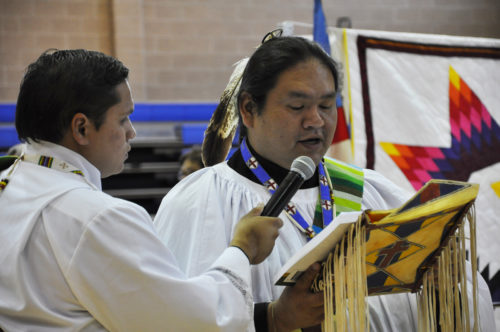
The Rev. Terry Star, with an eagle feather tied in his hair, reads the gospel during the June 17 Eucharist that closed the 140 Niobrara Convocation at Fort Yates, North Dakota. Another deacon, the Rev. Brandon Mauai, holds the microphone for Star. ENS photo/Mary Frances Schjonberg
[Episcopal News Service — Fort Yates, N.D.] The story is told that nearly 100 years ago an Episcopal bishop came to a gathering of Sioux Episcopalians to tell them they had to put away all things Indian in order to be good Christians.
To make his point, North Dakota Bishop John Poyntz Tyler had a barrel set in the middle of the gathering and told the Indians to put their Indian possessions in the barrel. When the men asked if the archdeacon had to give up the beaded moccasins he was wearing, Tyler replied, “Yes, those too.”
The barrel was sealed and taken out of the community, its contents never seen again.
Bill Little Bird, who was born in the early 1900s, was at that gathering and told the story to the Rev. Canon John Floberg, canon missioner for Episcopal community on the Standing Rock Indian Reservation. Floberg and others used the events of that story to offer an extraordinary reversal of the requirements of Tyler and others to the recent Niobrara Convocation.
The convocation is a nearly annual gathering of mainly Sioux Indians. This 140th meeting was held June 14-17 at the Standing Rock Community Middle School outside of Fort Yates on the portion of the reservation that is in North Dakota – the first time it has met in that state.
From the conference’s beginning the evening of June 14 until about noon on June 15, another barrel sat near the altar in the school cafeteria — a barrel that Presiding Bishop Katharine Jefferts Schori later described as a “barrel of shame and confinement.”
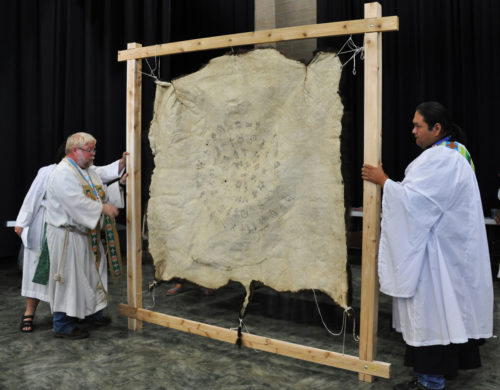
The Rev. Canon John Floberg, left, and the Rev. Terry Star set the Winter Count upright for the members of the 140 Niobrara Convocation to see during a June 15 service at Fort Yates, North Dakota, June 15. ENS photo/Mary Frances Schjonberg
As noonday prayers began on the 15th, some clergy on the reservation’s North Dakota side and North Dakota Bishop Michael Smith processed to the altar; Smith vested in rochet, chimere and Indian feather headdress. As they assembled, Cedric Goodhouse Jr. began to beat his drum and sing a “calling song” in Lakota: “I am coming from above, grandfather told me to come.”
The congregation then turned in the four directions as they sang the hymn “Chant to the Four Winds,” written by North Dakota Assisting Bishop Carol Gallagher, and prayed as a litany of massacres, relocations, a smallpox epidemic and broken treaties was recited. Next, the clergy surrounded the barrel and, with sage burning, opened it to remove a rolled-up buffalo robe. The robe was stretched carefully on a large frame and set upright in front of the convocation.
The inner side of the buffalo skin was painted with a counter-clockwise spiral of 72 black ink pictographs of the life of Jesus as told in the Gospel of Luke, thus making what the Sioux call a “Winter Count.”
Typically, a Winter Count contains one pictograph representing a memorable event in each year of a community’s life. Winter Counts were used in conjunction with oral history to tell the community’s story to its members and others.
Because the Bible does not contain a year-by-year account of Jesus’ life, this Winter Count’s 72 drawings were based on Jesus’ commissioning of 72 evangelists in pairs (Luke 10:1). The count begins at the center of the robe with a symbol that its creator Dakota Goodhouse, cousin of the drummer, said represented the time when in a “long time ago winter something holy came this way.”
The pictographs spiral from that event counter-clockwise, the direction a human’s hair grows from the spot on the crown of the head where Sioux believe the Spirit entered their bodies and left its mark of life spiraling outward, Goodhouse said during the service.
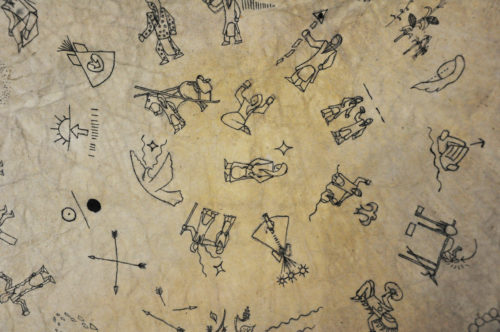
The Winter Count begins at the center of the robe with a symbol that its creator Dakota Goodhouse said represented the time when in a “long time ago winter something holy came this way.” ENS photo/Mary Frances Schjonberg
This Winter Count, destined to have a place near the baptismal font at St. Luke’s Episcopal Church in Fort Yates, is “a symbol for the community to decide what it takes out” to use to tell about the Christian faith, said Floberg, who has worked on the Standing Rock reservation for 20 years. He said that the robe was given in “respect and humility,” adding that he was speaking only of the North Dakota Sioux’s experience of being forced to put away their Indian things.
“I declare this buffalo robe, as a sacred expression of this culture, be restored as it was used in former generations to give honor, that it may honor Jesus and make his story known in and through his people,” Smith said during the service, which was a variation of the Book of Occasional Services’ liturgies for restoring things that had been made profane (page 317) and dedicating items for use in church (page 196).
Smith, with the congregation’s help, set apart the Winter Count and prayed to God that “through prayer and worship we may know you as you speak to us today.”
Floberg noted that Episcopalians use the service for restoring things that had become profane after, for example, a break-in had been committed in a church. “This is us saying we broke into their culture and we profaned their things that were sacred,” he told Episcopal News Service.
Winter Count’s presence is unusual
The appearance of a Winter Count to the tune of an Indian drumming and singing and, later during the convocation, the sight of Indian clergy wearing moccasins and eagle feathers and smudging the altar using sage and an eagle feather fan during the closing Eucharist, were highly unusual at Niobrara.
Also unusual, Floberg said, was Cedric Goodhouse’s decision to sing a pipe song in the noonday service. He sang in Lakota, “Look at the pipe, it is sacred. Look at the altar, it is sacred,” as the Winter Count was being unrolled and tied to its frame.
The Sioux traditionally consider the pipe a mediator between humans and the gods, Floberg said. Because Christians understand Christ to be a mediator between themselves and God, early evangelists treated the pipe as one of the Indians’ sacred items that had to be eliminated from their lives.
Attitudes towards restoring such things as the Winter Count to Native-American communities and their churches are complicated by the fact that, for most Sioux living today, “restoring” is not exactly what is happening. Most have never lived with those artifacts in their churches, according to Floberg and the Rev. Craig Wirth, vice itancan, or president, of the Niobrara Council. For instance, only recently have the beautiful and seemingly benign-appearing Sioux star quilts been allowed in Episcopal churches in the Dakotas, they each noted. (More information about such quilts is here).
Jefferts Schori, who attended this year’s convocation and preached at the June 18 Eucharist, praised the Winter Count project in her sermon. She called the painted buffalo robe “something to be blessed and proudly shared,” saying it was a “remarkable example” of efforts at “reworking what God planted here a very long time ago, partnering with the Creator, and continuing to expect more abundant fruit.”
“I can’t imagine a more powerful way to tell the Jesus story to those who don’t know it than in this gift offered by one who has listened well and met the creative power of the Great Spirit,” she said, referring to Dakota Goodhouse, who created the pictograph robe.
Jefferts Schori based her sermon on the day’s Gospel reading, which included the parable of the mustard seed. She told the congregation that everyone was meant to plant a seed and expect “a surprising and abundant harvest.”
“We don’t know what the mature plant will look like, but we can hope that this tiny seed will produce a tree of life for all the birds – Eagles, Red Birds, Two Hawks, Noisy Hawks and Driving Hawks, and maybe even some Fox, Elk, Bear and Horse people,” she said, invoking the family names of many of the Sioux present.
Anderson receives Lakota name
Both the presiding bishop and House of Deputies President Bonnie Anderson attended the four-day convocation. On June 15, a group of Cheyenne River Sioux and others gave Anderson a new name.
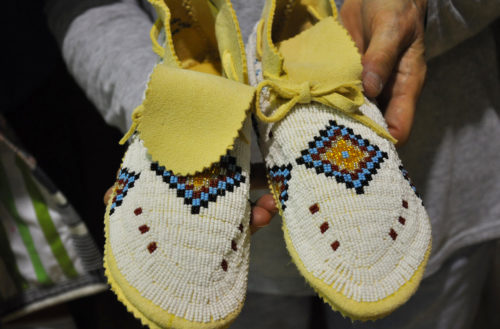
Linda Thompson, who lives on the Lower Brule Sioux Indian Reservation, made these beaded elk-hide moccasins for House of Deputies President Bonnie Anderson to wear June 15 for the ceremony during which she received the Lakota name Cante Tinza Win or Strong Heart Woman. ENS photo/Mary Frances Schjonberg
While the rest of the convocation participated in “sunset prayers” in the cafeteria, a group of about 25, including Diocese of South Dakota Bishop John Tarrant and Sioux Elder Wilbur Conquering Bear, gathered in a corner of the middle school gymnasium for the naming ceremony led by Don Metcalf, council sergeant-at-arms.
Anderson put on beaded elk-hide moccasins and stood on a patchwork quilt with her kola, or friend, the Very Rev. Ward Simpson, dean of Calvary Cathedral in Sioux Falls, South Dakota. The gathering turned in the four directions as it sang the doxology in Lakota. Then Metcalf announced that Anderson would now be called Cante Tinza Win, or Strong Heart Woman.
Metcalf told ENS that he chose the name because Anderson’s position as president of the House of Deputies called for a strong heart. “And she has a strong heart for Native American people,” he added.
The ceremony, however, was incomplete due to Sioux tradition. Metcalf explained that he could not tie an eagle feather in Anderson’s hair or give her a star quilt because his uncle’s daughter had died within the year. His elder, Ed Widow, on the Cheyenne River Reservation told him that to do so within a year of the woman’s death could mean that Anderson “might get a spirit of death,” he said.
Anderson will come to the 141st Niobrara Convocation on the Lower Brule reservation in South Dakota next June to complete the ceremony.
Jefferts Schori received the Lakota name Ni-ce Olewin, Looks for the Needy, during Niobrara in 2008.
Niobrara has long history
The Niobrara Convocation, first held in 1870, is the regular gathering of Native-American Episcopalians of what was the Niobrara Missionary District. It is said that although traditionally it included no Indian ceremonials, Niobrara has served the same social function as the sacred Sun Dance, when friends and relatives came together in the summer, and was not unlike the traditional affairs held in the camp circle each summer by the various tribes.
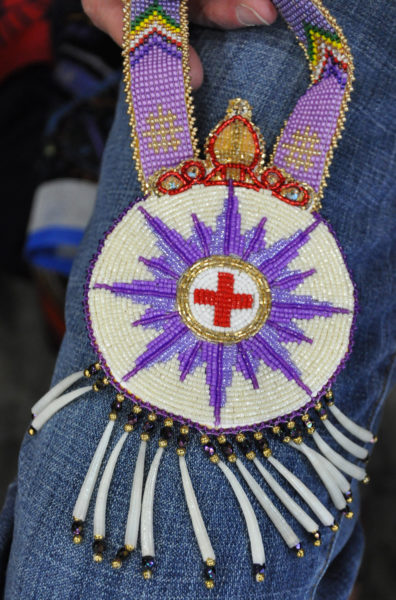
Emma Goodhouse, of the Standing Rock Indian Reservation, beaded an Anglican Compass Rose medallion for Presiding Bishop Katharine Jefferts Schori. The 16 dentalia at the bottom are scaphopod mollusk shells. ENS photo/Mary Frances Schjonberg
Some Sioux have revived the Sun Dance, and some Niobrara participants brought Jefferts Schori to visit a nearby Sun Dance on July 15. In her sermon, she called its revival part of “a search for healing from the pain of old destruction.”
Episcopal Church involvement with the Sioux began in the mid- to late-1800s after the 1862 Dakota uprising in neighboring Minnesota that resulted in the U.S. government deporting them to reservations in South Dakota. Just after the Civil War, the federal government offered land to various Christian denominations in exchange for their complicity in its effort to force Indians to assimilate into the white settlers’ culture through the federal government’s reservations system.
The Episcopal Church helped to carry out that plan mainly east of the Missouri River. The 1871 General Convention created the Niobrara Missionary District, which included parts or all of what are now North Dakota, South Dakota, Wyoming and Nebraska.
Today, life on the reservations in North and South Dakota, and large off-reservation portions of both states, can be partially described in a series of grim statistics. The three counties with the nation’s highest poverty rate, and four of the top 10, are in western South Dakota, according to U.S. Census Bureau statistics reported here. Ziebach County in the Cheyenne Reservation is first at 50.1 percent. Todd County in the Rosebud Reservation and Shannon County in the Pine Ridge Reservation are ranked second and third.
Eighty percent of the people living on the Pine Ridge reservation are unemployed, according to statistics here. Life expectancy is among the lowest in the Western Hemisphere: 48 years for men and 52 for women. The infant mortality rate is five times higher than the United States national average. The rate of amputations among diabetics there is two to four times higher than the national average.
The context of the Episcopal Church’s current mission and ministry in the Dakotas was made clear during the convocation’s “ingathering” on June 16.
Very small mission churches are spread over vast expanses of land. For instance, the Cheyenne River Mission in South Dakota has 11 churches serving an area the size of Connecticut. Two have indoor plumbing. All 11 are served by one priest, the Rev. Margaret Watson, along with a deacon and licensed lay ministers.
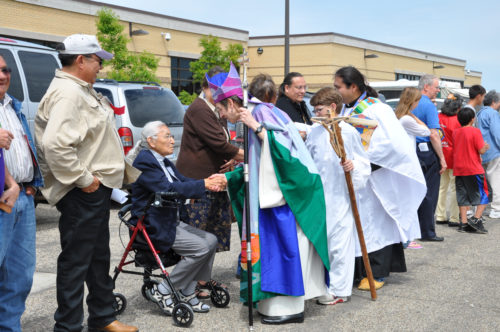
The Niobrara Circle is a traditional ending to the convocation in which all of the participants greet each other. The 140th circle was more of a line that looped through a parking lot of the Standing Rock Community Middle School in Fort Yates, North Dakota. As part of the greeting, Presiding Bishop Katharine Jefferts Schori shakes hands with the Rev. Hazel Red Bird, a deacon who serves on the Cheyenne River Mission in South Dakota. ENS photo/Mary Frances Schjonberg
The ingathering is when congregation members and clergy report on their activities and challenges since the last convocation. They spoke about concerns over paying off a propane bill from last winter and thanksgivings for new church windows that latch and eliminate the wind chill associated with standing at the altar. They reported on vandalism of their buildings; congregations revitalized and others closed; young people learning Lakota by learning to sing from the Dakota hymnal; skunks taking up residence under a church and forcing out the congregation; 66 baptisms and 41 burials conducted on one mission in the last year, of the frequency of funerals (one priest buried three babies in a row and then a 14-year-old girl in the past few days); and yet another suicide.
It is uncommon for Niobrara’s mission churches to have electricity, water and indoor toilets. Many reports included information about the introduction of those three so-called “luxuries” or the continuing lack of them. For instance, representatives of the Cheyenne River Mission announced a brand new “double-seater,” and those on the Pine Ridge Mission declared it “amazing” that two of their church buildings now have indoor plumbing.
With their reports came financial contributions. Most congregations in the council are aided by the two dioceses, which are, in turn, two of the four Indian Country dioceses aided by the Episcopal Church’s triennial budget (Alaska and the Navajoland Area Mission are the other two). Yet congregation members gather money via fundraising and individual contributions to help support the activities of the men, women and youth of the Niobrara Council.
Total pledges were typically in the $100-$200 range, but some were much smaller. For instance, a newly reopened church on the Lower Brule reservation in South Dakota that was described as “sit[ing] in the middle of nowhere on a hill overlooking the Missouri River” with an average Sunday attendance of 15 pledged $20.
During a break from the in-gathering, some congregations offered handmade star quilts for auction to raise money for causes ranging from that propane bill from last winter to an effort to defray the costs of a kidney transplant needed by one of the council’s members.
— The Rev. Mary Frances Schjonberg is an editor and reporter for the Episcopal News Service.

Social Menu